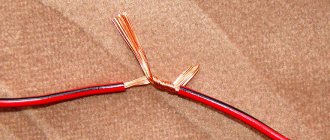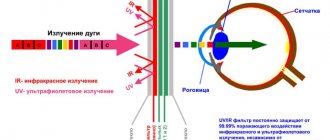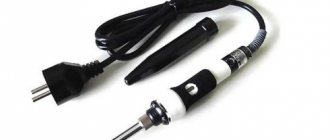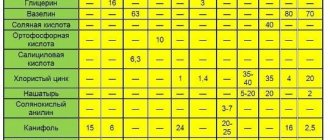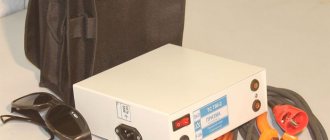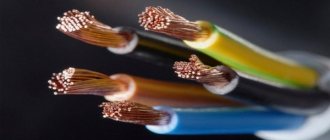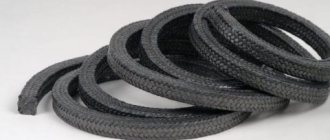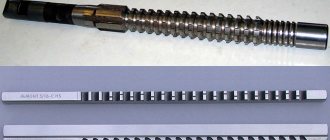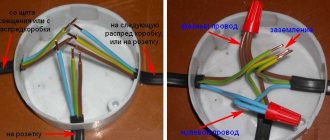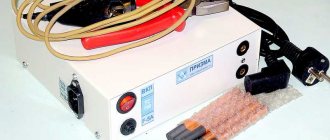In old houses and apartments, aluminum electrical wiring was made. This is due to the low price and availability of this metal. Nowadays copper conductors are often used, and there is a need to extend the core or install additional sockets, lighting fixtures, etc., but few people know how to connect aluminum and copper wire.
Consequences of contact between copper and aluminum
Let's consider the possible consequences using the example of a simple battery. Inside it there are 2 electrodes and an electrolyte. When metals interact, chemical processes occur and current is consumed or generated.
Some metals have oxidizing properties, while others have reducing properties. Their capabilities are indicated in the electrochemical voltage series. The degree of activity increases in one direction and decreases in the other. Here you can see compatible and incompatible contacts.
The farther apart metals are located in the electrochemical series, the greater the voltage between them will arise during a chemical reaction. The result of this will be the destruction of the metal located to the left.
If we compare nickel and cadmium, they are located nearby (through one element). The destruction of the latter occurs slowly; batteries or accumulators have a long service life.
Aluminum and copper have a big difference in the formation of stresses, so Al, located much to the left, will quickly collapse. A layer of oxides actively forms on its surface, which leads to deterioration of the contact and its overheating.
What happens when dissimilar metals join
Each conductor has its own electrochemical potential. This feature is successfully used in the manufacture of batteries and accumulators. But when two metals come into contact under conditions of humidity and stress, they begin to actively deteriorate. The results of this process are: fire of insulation, breakage of the electrical circuit.
Eliminating such a defect in hidden wiring will require time to detect, open and restore the surface of the walls. This happens when the splicing was performed by simply twisting two dissimilar cores. If connected correctly, the electrical contact will be reliable and will last a long time.
Rules for connecting copper and aluminum wires
Although it is not recommended to connect copper and aluminum cables, the need often arises. There are several ways to safely resolve the issue:
- By placing a third material between the conductors. To do this, it is better to use an inactive metal, such as brass, so that electrolysis does not start. Steel is highly conductive, so the joint will still heat up. This option is only suitable for networks with light loads.
- Reliable protection of the contact point from moisture. It is difficult to completely seal the connection, and it does not always work reliably. There are special pastes that prevent the entry of moisture and oxygen, so the wires do not oxidize and electrolysis does not begin.
WAGO terminal blocks
WAGO clamps consist of a self-clamping metal plate treated with anti-oxidation paste and a dielectric housing. Aluminum and copper wires are inserted into adjacent holes and pressed against one plate. Thus, the materials do not come into contact with each other and do not oxidize.
WAGO clamps are used mainly for groups of lighting devices, since with a high current load the plate can often burn out and the clamp itself can melt. Please note that the maximum cross-section of wires for WAGO clamps is 2.5 mm2, so we do not recommend installing a core thicker than this.
The advantage of WAGO terminal blocks is the speed of installation and compact dimensions, thanks to which the connections can be easily installed in the junction box. However, WAGO is quite expensive in terms of cost, and with a large number of connections it will cost its owner a pretty penny.
What is the difficulty of connecting directly
The main problem when joining copper and aluminum is the development of electrocorrosion. If the environment is dry, then nothing happens when these metals combine directly. Moisture acts as an electrolyte, creating a “battery effect”. Metals, especially aluminum, are destroyed, and a break appears in the network, which leads to a short circuit or fire.
Connection methods
To overcome the described difficulties, the connection of copper and aluminum conductors is performed using:
- direct contact (twisting, rivets, soldering, crimping);
- indirect (bolt connection, terminal blocks).
The second group is preferable. If the first method is used, it is recommended to pre-tin the wires with solder.
With bolts and steel washers
This is an affordable way, the necessary elements are easy to find. You will need steel bolts, for example M4, M5, non-galvanized washers and nuts.
First, the insulation is removed from the ends of the wires and bent into rings. Place washers on the edges of the bolt and between the conductors and tighten the nut. The result is a sandwich-type connection that does not allow direct wire contact.
The disadvantage is that the design is bulky, and at high voltages it still heats up.
Using twist
This method is convenient because there are no additional elements, but it is rarely used to connect copper and aluminum.
If the use of twisting cannot be avoided, then adhere to the following rules:
- the ends of the wires are twisted; mutual wrapping of one around the other is not allowed;
- the copper core is coated with tin, especially if it is multi-conductor;
- The contact area is protected with a moisture-resistant compound (lithol, technical petroleum jelly, etc.).
There are 3 types of twist:
- simple;
- bandage - gives the best result;
- groove.
If the diameter of the connected wires is up to 1 mm, make at least 5 turns, and for wires of a larger cross-section - at least 3.
With terminals
The terminal block contact group (brass tube with screws) is located in a protective plastic case. You just need to insert the ends of the wires into the terminal and tighten the screws. Do not apply much force when tightening, so as not to break the aluminum core. There are no partitions inside the terminal, so when inserting the wires, you need to make sure that they do not touch each other. After some time, the screws may become loose and contact will deteriorate.
Using Wago terminal blocks
German Vago terminals are easy to use: just insert the wire into the hole where the plate will fix it. The advantage of this design is that here each core is located in a separate cell, so they do not touch each other. The manufacturer has already applied a paste to the terminals that prevents oxidation processes. The disadvantage is that they are disposable and cost a little more than other terminal blocks.
Twist
Aluminum wires are often connected to each other using twisting. This is the simplest, but also the most dangerous method of connecting wires to each other.
The sequence of actions when using this technology will be as follows:
- First, remove the insulation from the wires approximately 4-5 cm on each side. It is most convenient to use a special tool designed specifically for this purpose.
- Now the contacts should be degreased. To do this, you will have to wipe them with a cloth pre-moistened in acetone.
- Sandpaper is used to remove the oxide film from the surface of the metal, that is, to clean it until a metallic shine is obtained.
- The wires are crossed with each other, after which one of the wires is wound onto the other as tightly as possible using pliers.
- The second wire is wound onto the first in the same way.
- The twist should now be insulated using insulating tape. Professional electricians also recommend using a special heat-shrinkable tube or cambric. With its help, you can qualitatively protect the exposed area from the negative effects of the external environment.
In principle, the technology is quite simple. You just need to remember that the wires need to be exposed at least 4-5 cm, and the twisting should not be done manually, but only with the help of pliers, so that the wires fit as closely as possible to each other.
If this is not done, the result will be loose contact, which can cause the area to become very hot. In turn, this effect causes a short circuit, and in some cases even a fire.
Connection adapters
To connect wires with a cross-section of more than 4 mm², use a clamp called a “nut”. It has plates in its plastic body. Wires are clamped between them. Such a connection turns out to be bulky, and it cannot always be hidden in a box or behind a baseboard.
To connect single-core aluminum and bundled copper wires with a screw terminal, brass lugs are put on their ends. They prevent soft aluminum from being crushed when clamping the screw. They prevent the possibility of breakage of some of the wires in a stranded copper wire, which leads to a reduction in its cross-section. Using a tip eliminates such problems.
You can make an adapter yourself. To do this, solder 2 small pieces of copper and aluminum wires. After this, twist the copper end with the copper, and the aluminum with the aluminum, reliably isolate the contact points, then connect the electricity.
Alternative options
Wago clamps
The method of connecting dissimilar wires using special spring clamps has recently become quite widely used. The most famous clamps are from Wago.
There are 2 types of such clamps:
- Disposable, without the ability to pull out the wire.
- Lever, reusable.
The principle of operation is a special spring clamp made of a special alloy, which is enclosed in a plastic case. The design of the clamping edge allows it to cut into the metal body even if there is a thick oxide film on it.
Clamps are produced for almost all used conductor diameters and are designed for currents up to 34 A. However, experience in electromechanical work suggests that the maximum permissible current must be reduced several times, that is, clamps must be purchased with some current reserve.
Wiring using spring clamps is the fastest. One of the disadvantages is the fairly high cost of materials.
Why can't you connect directly?
Aluminum and copper cannot be connected directly for the following reasons:
- These metals have different coefficients of thermal expansion. As they heat up and cool down, the geometry gradually changes, as a result of which the connection weakens, overheats and a spark appears.
- An oxide film forms on the surface of aluminum, impairing contact. It also begins to overheat and break down.
- Two metals form a galvanic couple. This leads to their overheating and the results described above.
Tips and tricks
To create the most durable and reliable connection between a copper and aluminum core, experts advise adhering to the following rules:
- perform reliable insulation;
- connections are placed in junction boxes so that they can be tightened later;
- if you do not have the appropriate skills, then do not weld or solder the wires yourself;
- the bolted connection is periodically tightened;
- if twisting is performed, it is additionally protected with PPE caps;
- better soldering is obtained by replacing rosin with pure machine or gun oil;
- the size of self-clamping terminals depends on the choice of cross-section of the wires that they will connect;
- copper wire must be tinned;
- Paraffin, varnish or oil are not used as waterproofing.
There is no single way to connect these wires correctly. To get a good contact, take into account local conditions and the accessories available at hand, and then select one of the described options.
